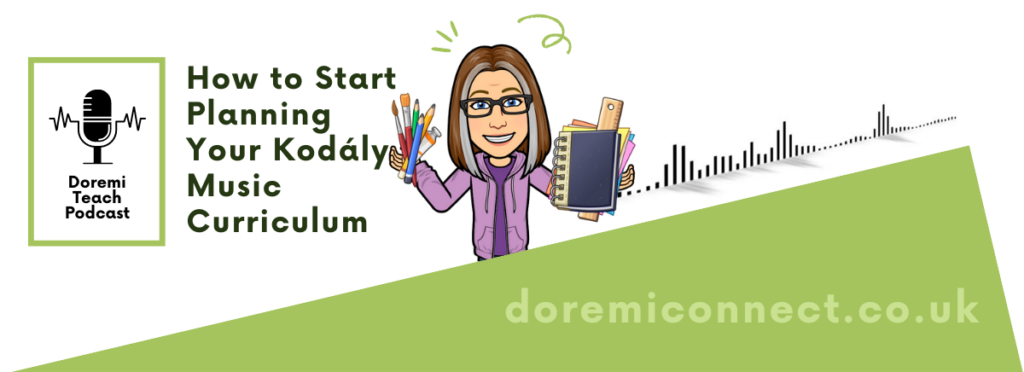How to start planning your Kodály Music Curriculum

Do you want or need to create a singing based curriculum for your school, class or club?
Maybe you’ve done some Kodály training but have been left highly motivated but not quite knowing where to start.
In today’s episode we’re going to walk you through some of the first planning tasks you’ll need to do to create your own Kodály curriculum
Key Points:
Good high level objectives for beginner musicians have the following seven qualities.
1 – are a single musical element
2 – exist in all music
3 – are really specific
4 – can be easily explained
5 – have clearly defined prerequisites or none
6 – have a clear path to the next step
7 – exist alongside the practice and preparation of other objectives
Starting with a massive list of possible contenders, Helen will help you narrow them down to the key objectives for your curriculum.
Transcript:
Do you want or need to create a singing based curriculum for your school, class or club?
Maybe you’ve done some Kodály training but have been left hugely motivated but not quite knowing where to start.
Today I’m going to walk you through some of the first planning tasks you’ll need to do to creating your own Kodály curriculum that works for you.
An ideal Kodály music curriculum will take a continuous path through many musical elements and skills. Each lesson progressing threads from previous lessons at the same time as preparing threads that will stretch into the future.
However, planning this infinite path hurts my brain. So unless you’re a super human, we need to break it up into sections to make the planning possible.
In the UK, the average half-term length is 6 weeks. So let’s start there. Which high level objective shall we cover in each half-term.
When I say high level objective, let’s be clear on what we’re NOT talking about.
I’m not talking about links to a topic. We’re not going to create a high quality and progressive music curriculum by handcuffing ourselves to “The Rainforest” or “World War II”.
I’m not talking about class sets of a particular instrument. The Kodály approach uses instruments, for sure, but not to teach things that can be taught faster, more effectively, more progressively and more enjoyably than through singing.
I’m not talking about preparing for a performance or event. If there are shows coming up in your school, that’s great. I love working with my choir and I think whole school singing is essential. But don’t replace our music curriculum with general ensemble singing and expect to see progression and understanding in musical skills or literacy.
So what AM I talking about? Good high level objectives for beginner musicians…
1 – are a single musical element
2 – exist in all music
3 – are really specific
4 – can be easily explained
5 – have clearly defined prerequisites or none
6 – have a clear path to the next step
7 – exist alongside the practice and preparation of other objectives
We’re going to take you on a journey with Clara to help you decide your own high level objectives. Clara is a primary school teacher and newly appointed music lead who would like to have a progressive, singing based curriculum in her school.
Clara doesn’t want to get overwhelmed so has sensibly decided to start with the first year. She can roll that out to EYFS and Y1, and maybe even Y2 in September.
But where to start? Clara loves mindmapping so she starts by writing down as many musical ideas as possible.
How many can you think of? Let rip, get everything down on paper.
Ideas:
Beat, rhythm, scales, pitch, high, low, clefs, crotchets, quavers, key signatures, texture, timbre, phrasing, form, time signatures, Italian terms, swing, harmony, chords, ostinato, singing, instruments, forte, loud, piano, soft, crescendo, repeats, composition, improvisation, sight reading, unison, polyphony, composers, classical music, folk music, playground songs, listening, jazz, bars, bar-lines, modulation, orchestra, opera, musicals, pop music, ukuleles, keyboard, percussion, duets, tempo, sharps, flats, major, minor, syncopation
Let’s group them into rough categories – this is an exercise not a definition
Time: Beat, rhythm, crotchets, quavers, time signatures, swing, bars, bar-lines, tempo, syncopation, form, repeats
Pitch: scales, clefs, key signatures, harmony, chords, modulation, sharps, flats, major, minor
Parts: harmony, ostinato, unison, polyphony, duets
Styles: composers, classical music, folk music, playground songs, jazz, orchestra, opera, musicals, pop music, texture
Performance: forte, loud, piano, soft, crescendo, Italian terms
Instruments: singing, ukulele, keyboard, percussion
Within each of those categories, identify the term that you think comes first. Are any of them prerequisites of the others?
Time: Beat
Pitch: High/Low
Parts: Unison
Styles: Playground songs
Performance: loud/soft
Instruments: Singing
So now we have six clear starting points. Which of them meet our criteria
1 – are a single musical element
2 – exist in all music
3 – are really specific
4 – can be easily explained
5 – have clearly defined prerequisites or none
6 – have a clear path to the next step
7 – exist alongside the practice and preparation of other objectives
I would say beat, high/low pitch and loud/soft performance.
Singing, playground songs, in unison are better suited to the delivery of the curriculum and can be utilised throughout every term.
So that gives us
Time: Beat followed by Rhythm – starting with long and short sounds
Pitch: High/Low followed by solfa – starting with so and mi
Performance: loud/soft
Do you want more support with your Kodály curriculum? Why not join me inside Doremi Membership? It’s where I hang out all the time supporting my members and sharing all my best stuff, including my own detailed Kodály curriculum and all the lesson plans and resources you need to deliver the best quality music lessons to your students.